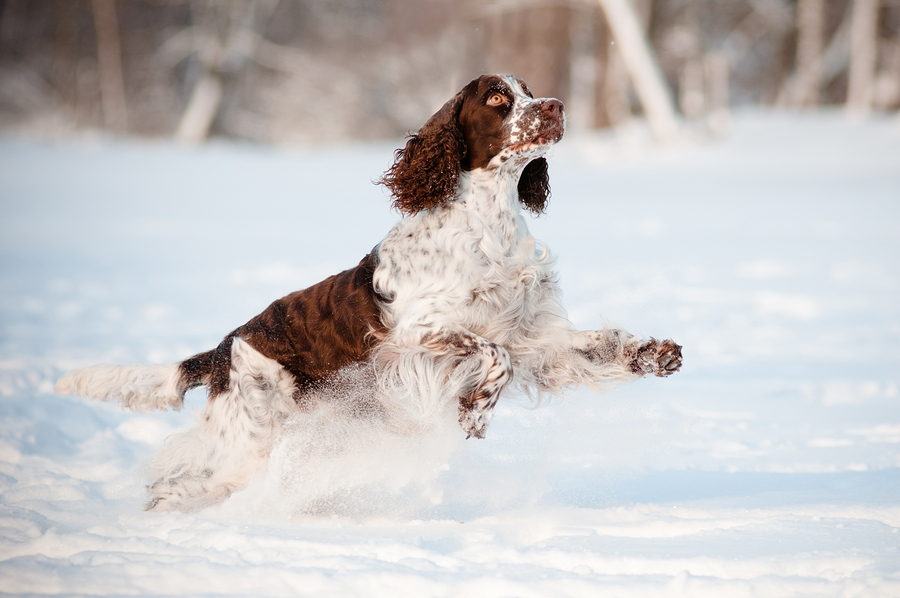Most dogs love snow, the exceptions being some small dogs and dogs without much haircoat. That said, throw a jacket and some booties on them and even dogs such as German Shorthaired Pointers love to skijor and sled. Here are some ideas for winter fun with your dog.
Backyard Play
The best snow for dogs to run and play in is light and fluffy. Dogs will run, pounce, leap into snow drifts, and chase each other with abandon. If you get a deep snow, blowing “a racetrack” or maze for them to run in the backyard can give them hours of fun and exercise.
Many dogs love going sledding. They may chase you on the way down and lead the way back up. Some dogs even like to ride the sled or toboggan with you. Either way, just take care that your dog doesn’t fall or run ahead of the sled and get hit!
Winter Dog Sports
Your dog can also pull a sled or toboggan if he is big enough. Choose an appropriate harness, one designed for pulling that fits him comfortably. Siwash-style harnesses with a bar before the attachment to the sled are popular. Sled and skijor races take place throughout winter months in many cold-weather states. Search for a race near you to meet experienced trainers and handlers and check out suitable equipment.
You don’t need to be Iditarod-ready to enjoy sledding. Most clubs offer a variety of races at different distances. Don’t be surprised at the breeds you see – along with Alaskan Huskies and Malamutes, you will spot German Shorthairs and Labs. A team of Standard Poodles has run the Iditarod. For short races, single dogs and teams of just 2 or 3 are common. Longer races tend to have full teams of eight or more dogs. https://www.sleddogcentral.com/clubs_usa.htm
Skijoring is usually offered along with sled-dog events. To skijor, you are on cross-country skis. Your dog is attached to your waist using a special harness and line. While you do a lot of the work skiing like normal, your dog can help speed you along as he runs in front. And you don’t have to enter a competition to have fun with skijoring. If streets are safe or you have nearby parks, you can do it just for fun.
If your dog is small or not into pulling, he can still enjoy winter outings with you. Once you have a track made with cross country skis or snowshoes, your dog can bop along behind you on the trail. For example, Corgis are short-statured dogs who love snow and winter outings.
Where can you practice these activities if you don’t have a safe or convenient place to do so? Check Sniffspot.com for inexpensive hourly rentals of dog-friendly yards or other areas.
Winter Fitness
For any snow activities, your dog should be in good shape. That means reasonably fit and at a good weight. Working in the cold is an extra stress, and deep, heavy snow can add to the workout. Take special notice of your dog’s feet. He may need ointments to help keep his pads from cracking or booties to help with traction and cold. Some dogs will need a coat, while coated dogs such as Siberian Huskies, Norwegian Elkhounds, and other spitz breeds are happiest in cold weather wearing only their birthday suit.
Safety Tips
Avoid activity in deep, heavy, wet snow and ice. Letting dogs play in those conditions can easily lead to orthopedic injuries. Very cold temperatures could put your dog at risk of frostbite. Tails without a fluffy covering of hair and the tips of upright ears are areas where frostbite tends to strike first. Use common sense – short outings, with your dog being active, will help keep him warm. Don’t hesitate to put a coat on a shorthaired dog. Make sure coats are dry and clean before putting them on your dog.
Be careful if you walk along roads or paths that are plowed and then treated for ice. While many areas use pet-safe ice melters, road salt can be extremely painful to dogs. They may also be toxic, or at the least upsetting to the stomach, if your dog licks his paws. Booties are almost a necessity for city walks in winter. If your dog won’t tolerate them, plan on carefully wiping and cleaning your dog’s paws after each outing. Pair foot care with your dog’s favorite treats to keep it positive.
Have fun and stay warm and safe!
This article was reviewed/edited by board-certified veterinary behaviorist Dr. Kenneth Martin and/or veterinary technician specialist in behavior Debbie Martin, LVT.








